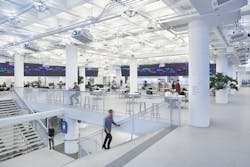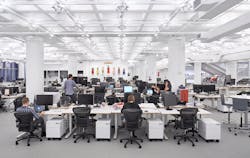To cope with the “blues,” humans have long turned to music and chocolate. Now they may need something to combat another type of blues — the one that exists in the visible light spectrum.
Blue light, whether delivered naturally via the sun or artificially via luminaires, has been the subject of growing scientific interest for its influence on people’s sleep patterns, alertness, mood, overall health, and even susceptibility to disease. A growing body of research affirms that blue light is particularly potent, impacting the human biological clock and the body’s mysterious circadian rhythms both positively and negatively, depending on the timing, intensity, quantity, and overall quality of the exposure.
Photography by John Muggenborg / www.johnmuggenborg.com
In that sense, blue light is neither good nor bad; it’s merely a fact of life in nature and increasingly — with the proliferation of blue-rich LED lighting — more artificially illuminated spaces. But an ever deeper understanding of it and other spectral components of light, combined with continued advances in LEDs and lighting sensor/control technology, is opening a new frontier in lighting solution design. It even has a name — one coined to try to convey the need and growing ability to take a more enlightened approach to illumination — human-centric lighting or HCL.
Vaguely descriptive of a strategy to optimize lighting for the benefit of people in a given space, using growing awareness of light’s array of hidden powers and the emergence of tools to finely control it, HCL is fast becoming one of the lighting industry’s most talked-about concepts. In the industry’s lexicon for a decade or more, after sprouting in European lighting circles, HCL is now on the lips of a growing number of industry professionals — from lighting products manufacturers, designers, and architects to consultants, researchers, and academics.
But as fast as HCL has become trendy, there’s anything but consensus around it — on what it really is, how to actually design it, and even whether the lighting industry should be promoting its deployment. HCL, and, more importantly, how it’s being both interpreted and leveraged in the marketplace, has become a hot-button issue and a lightning rod for debate.
“HCL is a controversial term, one the U.S. Department of Energy dislikes,” says Robert Karlicek, director of the Center for Lighting Enabled Systems and Applications (LESA) at Rensselaer Polytechnic Institute, Troy, N.Y. “One argument against using the term is that all lighting is human centric in some way because it’s all utilized by humans. For most, though, it means lighting designed to optimize light’s spectral qualities to improve human performance in some way.”
The debate over HCL is more than just semantic. Karlicek says there are different schools of thought on the wisdom of making claims around HCL. While the scientific evidence is strong that humans can benefit in myriad ways from more thoughtfully designed lighting, he says, it may be risky and premature to peddle HCL as a vehicle for producing tangible, measurable benefits for either humans or organizations that deploy it.
“We don’t know and don’t yet have comprehensive studies demonstrating a hard return on investment for HCL that would make one want to run out and buy something tagged as HCL,” Karlicek says. “There are some little studies showing its benefits, and some testimonials, but not enough quantitative, hard data. That research is hard to do and takes a long time.”
Photography by John Muggenborg / www.johnmuggenborg.com
Karlicek is hardly alone in his wariness to fully embrace or endorse HCL based on limited clinical data for the HCL products that are on the market today. Deborah Burnett and Jim Benya, principals at Benya Burnett Consultancy, a lighting consulting firm in Davis, Calif., also caution that explicitly selling lighting as a recipe for improving productivity, enhancing mood, promoting health, or otherwise influencing performance and outcomes is problematic. There’s no doubt, they say, that lighting solutions that comprehensively manage human exposure to both natural or artificial light in a space are more deliverable than ever. The larger question is what solutions billed as HCL actually end up delivering — and whether the lighting marketplace is getting ahead of itself in embracing a concept that still needs a lot of refinement.
“There’s support for the notion that light plays a role in health and wellness, but we don’t yet know how to do it right,” says Benya. “Products sold with any promise like that, you’re doing it without the benefit of any solid medical evidence.”
Burnett, part of a cadre of researchers studying links between light and human health, says there’s a risk that some solutions marketed as HCL may reflect only a surface understanding of the complex light-brain/body connection. The danger, she says, is that many may latch on to the HCL buzzword and promote lighting solutions whose purported value may be difficult to measure, limited in scope, and possibly even counteracted by unforeseen negative consequences.
“Manufacturers of HCL products might think they’re doing the right thing, but, in essence, they might not be,” she says. “This is much more complex than installing color-changing light bulbs.”
Color confusion
In broad terms, light color — and the prospect of controlling human exposure to its myriad expressions along the visible light spectrum — lies at the very heart of HCL.
Light’s correlated color temperature (CCT) — from high-Kelvin temperature blues that produce cool-appearing light to low-Kelvin yellows that produce warmer light and everything in between — impacts how people visibly experience illuminated spaces with their eyes. But that’s not all. As scientists are discovering, bodies also use light. Different colors along the spectrum have components that produce different biological responses, many of which interact with the body’s inner clock and roughly 24-hour cycle that spans deep sleep and hyper alertness.
Blue light in the 4,600K-and-up range, present in the morning sun, is thought to be the most pivotal in terms of biological impact. Extensive research has shown that its uptake signals the body to action, stimulating the stress hormone cortisol and producing heightened wakefulness and concentration. Blue light naturally diminishes as the day progresses, gradually replaced by yellower, warmer light that blocks stress hormones and reactivates melatonin, the primary sleep hormone, signaling the body to begin the wind-down phase.
All the colors present in white light are naturally experienced, to different degrees, depending on factors like the degree of occlusion, the season and geography, by exposure to the sun, from daybreak to dusk, and even into the darkest night. In a fully natural environment, the body becomes attuned to the shifting color and other qualities of light, setting up an optimal asleep-awake cycle that is also thought to also help foster the body’s ability to thrive and ward off disease. But light color, of course, is also transmitted by artificial illumination, although largely in a mostly static, very narrow range. That’s artificial lighting’s primary handicap — the one the lighting industry is trying to address with a new generation of lighting technology and updated design schemes oriented to markedly improving how humans fully experience light… in other words, HCL.
Photography by John Muggenborg / www.johnmuggenborg.com
Luminaires and lighting systems capable of changing color, products that result from advances in LED microprocessor chip technology and programmable digital lighting controls, are at the heart of solutions pitched as HCL. A growing number of companies are bringing these so-called tunable white lighting products to market, lured by the prospect of selling lighting upgrades on a new value proposition — one that extends beyond energy savings and the prospect of replacing lighting less often. The market’s rapid adoption of longer-life, energy-efficient LEDs has produced intense competition that has not only squeezed suppliers, but also limited opportunities for repeat sales, long a bedrock of the industry’s business model.
A new frontier
The proposition behind color tunable lighting is that users will be able to better control the subtler qualities of light in a space, moving well beyond the ability to simply control when luminaires turn on and off, the intensity of the light with dimmers, use occupancy sensing, and implement plug load controls. Exposed to lights programmed or otherwise controlled to deliver a range of CCTs, depending on the time of day, space utilization, whim, or a host of other variables, people in the space could potentially derive a host of aesthetic and possibly even biological benefits. No longer hemmed in by luminaires operating in a narrow color range, especially those that emit a constant amount of blue light through the day, users’ productivity, mood, sleep, and health could perhaps improve, at least marginally.
While lighting suppliers might lack the hard and fast evidence to irrefutably back that up, says Karlicek, many nonetheless appear confident enough, and justifiably so perhaps, to bring color- tunable products to market.
“The reality is that we know light can impact people,” he says. “Most lighting designers and manufacturers say that we know enough about the potential impact of light color tuning that we need to talk seriously about lighting design specifications that focus on human health and well-being.”
But others, like Burnett, see an industry that may be taking too much liberty in translating the HCL concept to a line of products. Burnett argues that the lighting industry fails to grasp the core science behind the delivery and uptake of light color — and that products and sales pitches made on a biological activity basis are too simplistic. For one thing, light as experienced by the body is multi-dimensional in terms of qualities, she says, and focusing just on what the eye sees in terms of color is a mistake, a critical error if the goal is to somehow influence bodily circadian rhythms.
“Just because what we perceive to be the color of natural light recreated in artificial form doesn’t mean it’s anywhere close to the real thing when you correctly assess the light for its energy signature,” she says. “The body, brain, eyes, and skin of every living being uses several differing variables of the energy contained within the light for its biological survival.”
Luminaires designed to deliver a range of CCTs can mimic the look of sunlight at different times of the day, Burnett says, but can’t by themselves faithfully replicate factors like intensity, distribution of color bands, angle and other subtler shifts in light quality that occur as the sun traverses its path. Those features essentially can’t be integrated into a single luminaire, meaning that many units branded as HCL, or especially circadian, fall short of any definition that implies biological activity.
“You can’t specify electric light and say it will do the same thing,” she says. “Electric light can’t give the body everything it needs.”
Applications grow
Nevertheless, lighting projects employing color-tunable luminaires continue to seep into the marketplace for new and retrofit spaces. Much of the activity has been centered in educational, health care, and residential care facilities where improved lighting might eventually pay clearer and potentially larger dividends. Schools are interested in the prospects for improving student attention, while hospitals and care facilities eye HCL projects for their potential to replace harsh institutional lighting in facilities often hobbled by a lack of natural light features, thereby positively impacting patient and visitor comfort on some level.
Kaiser Permanente San Diego Medical Center opened in April 2017 with an all-LED lighting system designed to deliver steadily changing light color — blue to yellow — to specific areas over the course of a day. Patient rooms are a centerpiece of that automated feature, but manual controllability is incorporated. The design also relies heavily on natural light, which complements color-tunable luminaire features managed by sophisticated lighting controls. The design received the Illuminating Engineering Society’s 2017 Lighting Control Innovation award.
HCL is also finding its way into the office space market. In 2016, New York advertising firm R/GA moved into a redesigned space in Manhattan that incorporated a circadian lighting scheme that featured color-changing luminaires. Designed by Tillotson Design Associates, a New York lighting design firm, the lighting was initially programmed to be 2,700K in the morning, transitioning to 4,000K midday, and backing off to 3,000K in the evening.
Dagmara Nowak, a Tillotson senior designer, says R/GA was interested in experimenting with an HCL approach. After it was installed, however, R/GA tinkered with the system, backing off the 4,000K and possibly changing other elements of programming, she says.
That project was an early HCL venture for Tillotson, and Nowak says HCL presents opportunities for meeting evolving client needs.
“We think the approach of having lighting follow the rhythm of the day to some degree has a future,” she says.
Zind is a freelance writer based in Lees Summit, Mo. He can be reached at [email protected].
Sidebar: Headquarters Lighting Project Departs from Standard HCL Approach
A truck could be driven through a term as general as human-centric lighting (HCL), but some interpretations are passionately well-defined.
One is a project at the Washington, D.C., offices of the American Society of Interior Design (ASID), where the designer factored a host of mostly static conditions in the built environment into a circadian lighting system geared to benefitting occupant health and well-being.
The designer, Benya Burnett Consultancy, Davis, Calif., analyzed building orientation, latitude and time zone locations, seasonal sun angles, weather patterns, shadows from adjacent buildings, office furniture dimensions and colors, and even information related to employee sleep and after-work hour activity levels obtained through interviews and surveys.
The result is a lighting system that bucks conventional approaches to HCL on several levels, including the installation of both high-output fluorescent lighting and LEDs. Unlike many HCL projects that focus narrowly on (CRI) color rendering index) and (CCT) correlated color temperature, the ASID design focused on the sources’ combined spectral power distributions (SPD), a measure of wavelength energy output for any given light source across the visible spectrum. In designing wellness-based lighting projects like ASID, Benya Burnett principal Deborah Burnett says the energy contained within the light, which can vary between light sources of the same CCT, matters more than the color seen.
“To design wellness-focused interior electric lighting intended to emulate the natural light received by our eyes and skin while outside, we had to specify a lighting design that provided more than simple color changes over the course of the day and provide instead a combination of light sources which energetically came as close as possible to natural daylight,” she says.
The ASID design considered the amount and timing of natural light penetration, as well as reflected light from carpeting, walls, furniture and window shading materials. Along with information about occupant wellness, lifestyle and workstyle, that helped Burnett fashion a lighting scheme tailored for lighting direction, intensity, duration and spectral energy.
“We approached it from a ‘first do no harm’ perspective so that we would not inadvertently negatively impact occupants’ sleep and overall well-being as they worked through the pre-dawn, mid-morning, afternoon, and evening hours,” she says.
Nearly two years after its May 2016 installation, the system is functioning mostly as designed, and has been well received by those who work around it, says Susan Chung, an ASID senior research associate. Some evidence has been collected to connect it to improved productivity and employee well-being, but it’s too soon to draw definitive conclusions, she says.
There’s anecdotal evidence of impact, though. Three months after it was installed, ASID’s vice president of communications, Joseph Cephas, says he noticed he was getting tired and ready for bed earlier in the evening. Given the timing, he became convinced it resulted from exposure to the pre-determined appearance of an early evening transition to a more reddish color light thought to be ideal for workers under the age of 40. Experiencing better sleep quality, and suspecting a link, Cephas installed lighting billed as circadian at his own home.
The circadian protective lighting design was a key component of ASID’s broad-based building wellness project. It helped the building meet the International WELL Building Institute’s WELL Building Standard at a Platinum level in July 2017. The building achieved notoriety for becoming the first one in the world to achieve Platinum for the both the WELL standard and the U.S. Green Building Council’s LEED standard for energy efficiency.
About the Author
Tom Zind
Freelance Writer
Zind is a freelance writer based in Lee’s Summit, Mo. He can be reached at [email protected].




